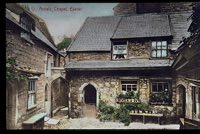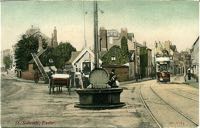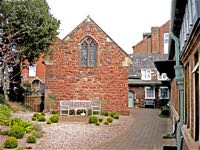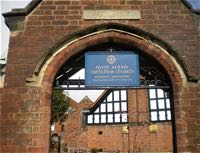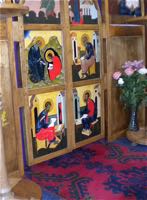
St Anne's Chapel & Almshouses – Blackboy Road
Researched and written by Julia Sharp
Page updated 13th November 2017
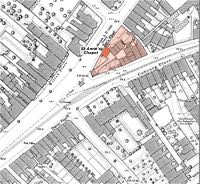 Situated in St. Sidwell’s on the fork between Old Tiverton Road and Blackboy Road is a medieval Chapel and adjacent Almshouses. The Chapel now called St. Anne’s Orthodox Church was possibly named after the Patron Saint of Weavers, in recognition of the many weavers in St. Sidwell's parish.
Situated in St. Sidwell’s on the fork between Old Tiverton Road and Blackboy Road is a medieval Chapel and adjacent Almshouses. The Chapel now called St. Anne’s Orthodox Church was possibly named after the Patron Saint of Weavers, in recognition of the many weavers in St. Sidwell's parish.
The site originally housed an ancient Hermitage and was thought to be a good place to attract worship and offerings from passing travellers. This attracted John Wygwer, a chantry priest at the Cathedral, to get contributions of money from the Earl of Devon, and others, to build a votive chapel to St. Anne and All Saints on the site. Soon after it was licensed, in 1418, it was said that William Billeford arranged a clandestine marriage between John Gascoigne and a woman called Matilda. This resulted in the Chapel losing the right to say mass and Billeford being taken to Court. The right to say mass was restored, but the Dean and Chapter took over the right to offerings from John Wygwar. The amounts can be found in the cathedral accounts, from 1477 being standardised at 6s 8d per annum until the Reformation.
After the Dissolution of the Monasteries in 1539, the Chapel became the property of Oliver and George Mainwaring. In 1561 they built some Almshouses to house eight needy people on the site; the patronage for which was given to the Dean and Chapter. They were responsible for the fabric of the building but not the occupants who received a small income from several bequests that were made over the years. St. Anne’s Chapel became the Chapel for the Almshouses.
Because of the commanding position on the edge of the City, the Chapel was fortified by Fairfax during the Civil War at the time of the siege of the City in 1646. This left the buildings damaged, a state they remained in for some time. They were still shown on the various maps of the period. In Benjamin Donn’s map of 1765 the Chapel is called St. Agnes Chapel, and Tozer in his map of 1792 mentions St. Anns Chapel alias St Agnes Chapel. It can therefore be assumed the chapel and Almshouses were still being lived in. While the Almshouses remained in use, according to one source, St. Anne’s day 26 July was still observed by the inmates of the Charity as it had since its foundation.
In 1837 there are newspaper reports of a plan to improve the entrance to the chapel by the erection of a handsome Gothic Gatepost with a new and handsome Clock. The Dean and Chapter, having given their consent, declared their willingness to subscribe £40 towards the expenses. Promises of £63 were made, and more had been obtained, and the Commissioners were asked for £10 more.
At this time the newspapers called the residents of St. Sidwell ‘Grecians’ or ‘Greeks’. The term possibly relates to the rivalry between youths of Exeter and St Sidwell, one being resident in and the other outside the Walls. Also in 1837 the newspapers record the fact that the proclamation of the new Queen, Victoria was not made at the ‘proper’ time in St. Sidwell. However the Town (Exeter) Council had rectified that with the Proclamation being read outside St Anne’s Chapel "‘to the great consolation of the Grecians in general.’ The procession passed off excellent well; however towards the close there was a slight disturbance, occasioned by one of Mr. Saml. Kingdon’s sons."
Whether any further restoration took place at that time is not known, but around the turn of the 20th century, major changes were being discussed. Firstly the Dean and Chapter undertook major works at the Almshouses, initially reducing the number of tenants, about 1905, from 8 to 4 in two houses, and then in April 1907 placing a advertisement for ‘Builders willing to tender for the erection of new almshouses’. Luscombe took up the challenge and the year 1907 can be seen on the drainpipes in Blackboy Road. When the work was completed the number of residents could be increased to the original figure.
The Dean and Chapter then gave up the responsibility for the Chapel which is now managed by the St. Petrock and Heavitree Parish Lands Charity (the Parish Lands Charity) Nothing much changed during the early part of the 20th Century although some more work was undertaken and the Gateway now has a date of 1927.
The chapel had always had connection with St. James parish, which became of more importance when St. James became a victim of the Exeter Blitz. The congregation used St. Anne’s until the St. James was rebuilt about 1956. The Chapel still has a connection and uses the facilities on occasions, possibly when large congregations are expected.
Without the need for a Chapel for the Almshouses, the future looked bleak. However, in the 1980s the Chapel was taken over by the Orthodox Church on a long term lease.
The Orthodox Parish of the Holy Prophet Elias, was formed by Father Barnabas, who was born in mid-Wales, and became an Orthodox Priest in 1960. He wanted to found an Orthodox Monastery in England. This he accomplished in 1967 at Willand in Devon. By the 1970s there was a growing community of Orthodox believers especially in Exeter, possibly because of the number of Students at the University with an orthodox background. During the 1980s the Church found the Chapel of St. Anne and obtained a long lease at a peppercorn rent.
Now the medieval chapel with a cradle roof and niches on the walls, is home to a number of orthodox icons covering the walls, and an Iconostasis, a wooden screen with holy icons, which separates the sanctuary from the nave leaving space between according to the Orthodox tradition.
Originally the Orthodox chapel called itself The Greek Orthodox Chapel but now is simply Orthodox to better reflect the many nationalities which make up the congregation, which sometimes numbers 70 or more, especially at the time of the Orthodox Easter.
A tight squeeze for the little votive chapel of the 1400s.
Sources: The British Newspaper Archive, Churches of Medieval Exeter by Nicholas Orme, Exeter Past by Hazel Harvey, Exeter Almshouses by Jane Passmore, Exeter, Profile of a City by Paul Hardy, Exeter Paintings, items on the web, visit to site. Julia Sharp
│ Top of Page │
